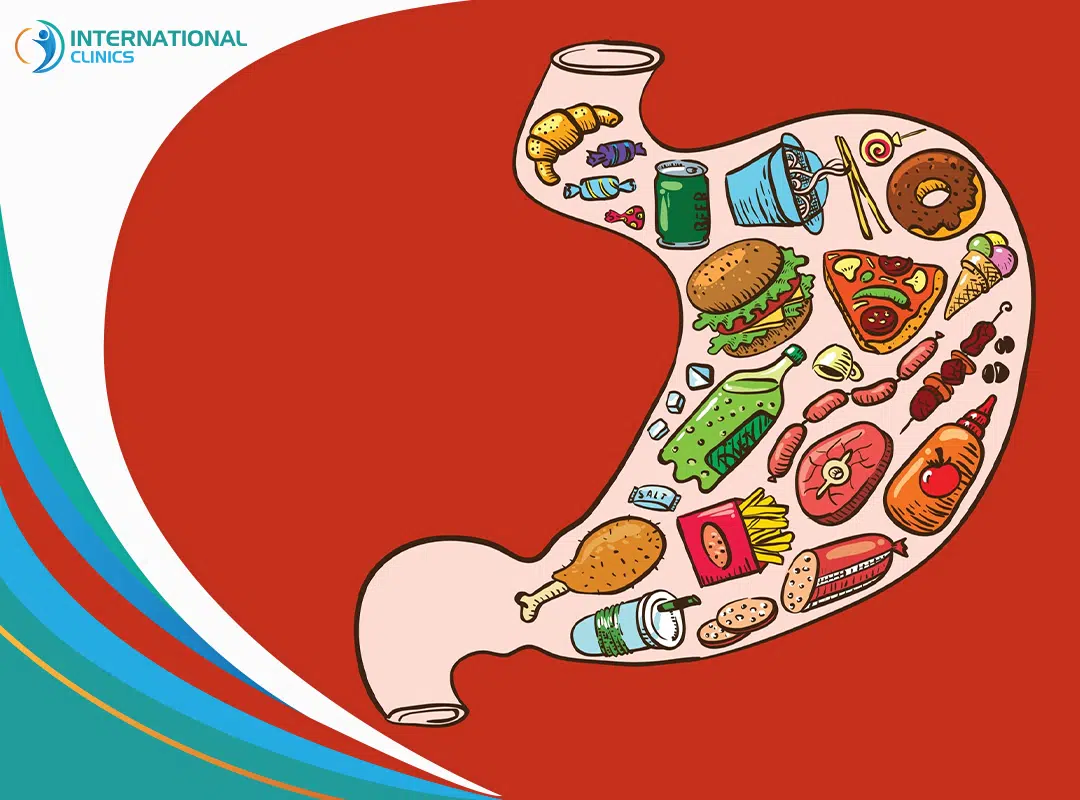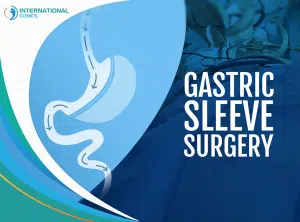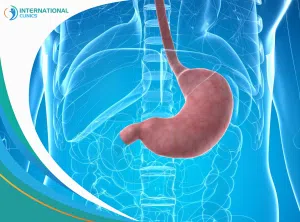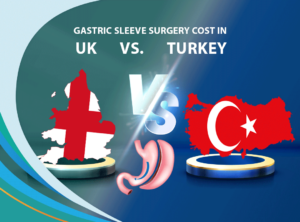Obesity is a growing health concern in every corner of the world, but for some people, bariatric surgery might offer an effective solution when other weight loss methods have not worked.
Bariatric surgery, also known as weight loss surgery, refers to a variety of procedures (such as gastric sleeve) that aid weight loss by limiting the amount of food the stomach can hold.
If you have struggled with severe obesity and related health conditions like diabetes, sleep apnea, asthma, high blood pressure, or arthritis, your doctor might offer gastric sleeve surgery in Turkey as a potential treatment option.

One of the most common bariatric surgery procedures performed today is gastric sleeve in Turkey. In this surgery, the surgeon removes approximately 80% of the upper and middle sections of the stomach, leaving a smaller tube-like pouch.
Due to the reduced size of the remaining stomach “sleeve,” patients feel fuller sooner after eating and cannot consume as much food as before.
The surgery also decreases levels of ghrelin, the “hunger hormone” produced in the stomach, which often leads to less desire for food. With a smaller stomach capacity and decreased appetite, sleeve gastrectomy enables significant weight loss for most patients.
However, there are many sleeve gastrectomy types. Next, we’ll take a deep look at these types and discuss other facets of this popular procedure.

Understanding Gastric Sleeve Surgery
Gastric sleeve surgery, also known as vertical sleeve gastrectomy, is a weight loss procedure that reduces the size of the stomach.
During the operation, the surgeon removes approximately 80% of the stomach, leaving only a slim, banana-shaped portion.
This remaining gastric “sleeve” is then closed up with surgical staples. The dramatic reduction in stomach size limits the amount of food intake, causing patients to feel full and satisfied after eating only small portions.
By restricting food intake, gastric sleeve surgery facilitates significant weight loss, typically between 50 to 90 pounds in a couple of months. It provides an effective solution for chronic obesity, especially when other diet and exercise programs have not worked.
Gastric sleeve surgery has evolved from earlier forms of bariatric surgery. One predecessor was vertical banded gastroplasty, commonly called stomach stapling, which is no longer performed.
Initially, the sleeve gastrectomy procedure was utilized as a first step before gastric bypass or duodenal switch surgery. Over time, surgeons realized that sleeve gastrectomy alone offered excellent weight loss outcomes. Also, there are many sleeve procedure options available in hospitals and clinics.
Different Types of Gastric Sleeve Surgery
The gastric sleeve can be done using different techniques that often affect gastric sleeve cost in Turkey. The most common of which is the laparoscopic procedure or vertical sleeve. However, as technology advances, other techniques have entered the medical scene in the last couple of years.
Laparoscopic Sleeve Gastrectomy (LSG)
Laparoscopic sleeve gastrectomy (LSG) or multi-port surgery is the standard approach for gastric sleeve surgery.
It’s often done in a hospital under general anesthesia. On average, LSG takes around 2 hours and requires a 2-day hospital stay.
Your surgeon makes about 5 small incisions in the abdomen and inserts a laparoscope – a thin tube with a tiny camera on the end.
The camera provides a view of the stomach on a monitor screen. Instruments inserted through the incisions are used to remove approximately 80% of the patient’s stomach, which will determine the sleeve diameter.
Many analysts hint at 2004 as the starting date for a laparoscopic sleeve. They also emphasize the procedure being a part of a two-step weight loss surgery plan for patients with extreme obesity.
However, it has been proven to be effective on its own and is now an established standalone bariatric procedure.
In LSG, the surgeon removes the fundus, which is the curved, upper part of the stomach. The remainder of the stomach is reshaped into a narrow banana-like “sleeve” using surgical staples.
Because of the reduced stomach size, patients feel full faster when eating and consuming smaller amounts.
Additionally, the fundus contains cells that produce ghrelin, a hormone that stimulates appetite.
Removing this section may suppress hunger urges after surgery and contribute to weight loss.
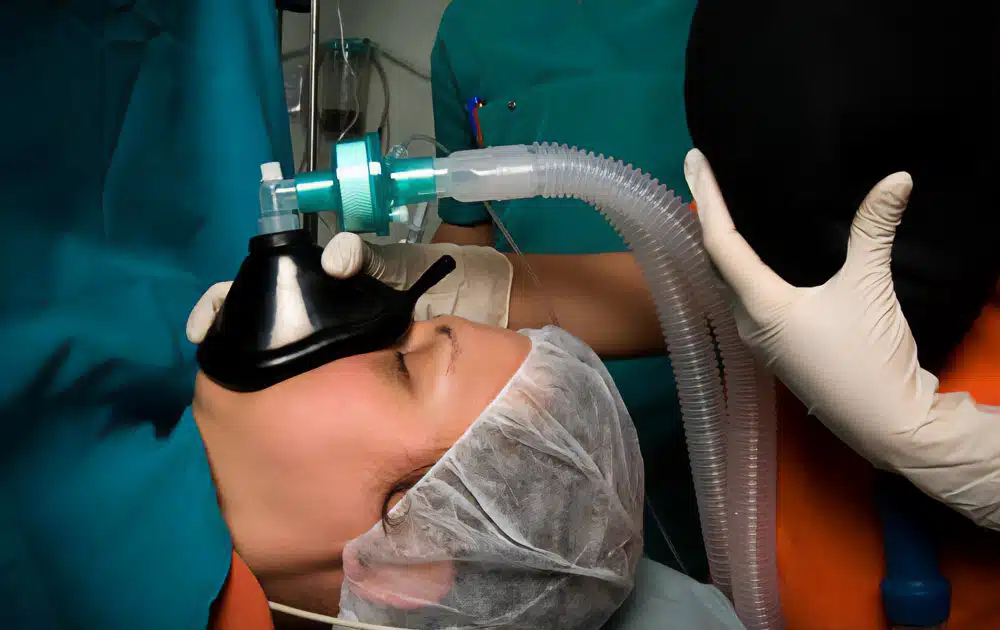
Robotic-Assisted Sleeve Gastrectomy
Robotic-assisted surgery is an emerging option for weight loss procedures like gastric sleeve and gastric bypass.
The robot tech allows the surgeon to perform operations through tiny incisions using enhanced visualization and precision instruments.
During robotic surgery, the surgeon sits at a console next to the patient. The console provides a 3D high-definition view of the surgical area, magnified ten times over normal vision.
The surgeon also uses joystick-like controls to maneuver robotic arms equipped with a camera and tiny surgical tools.
This allows for a greater range of motion than human hands. Above all, robotic instruments can bend, rotate, and move delicately in ways exceeding normal human wrist function.
Built-in tremor reduction features enable smooth, steady instrument movement. The surgeon has complete control of the robotic system at all times.
Compared to traditional laparoscopic techniques, the robot arm offers potential benefits for bariatric patients including:
- Shorter hospital stays after surgery
- Decreased likelihood of needing additional revision surgeries
- A lower risk of leaks from stomach connections
- The ability to perform complex maneuvers with enhanced precision

Single-Incision Sleeve Gastrectomy
Single-incision laparoscopic surgery (SILS) is an advanced, minimally invasive technique for weight loss. SILS only requires a single small horizontal incision, usually through the navel or belly button.
In contrast, conventional laparoscopic surgery uses 3 to 5 incisions across the abdomen. With just one incision point for SILS, there is only one barely noticeable scar after surgery, which fades significantly within 6 to 12 months.
SILS is gaining popularity for its aesthetic benefits and use of state-of-the-art surgical methods. The surgeon inserts all the necessary instruments, like a tiny camera and tools, through the single belly button incision.
This access point enables the removal of stomach tissue to create the gastric sleeve. During a consultation, the surgical team can determine if single incision surgery is appropriate based on factors like the patient’s BMI.
SILS may be recommended for patients with a BMI under 40, whereas multiple incisions are typically needed for higher BMIs.
Compared to traditional laparoscopy, potential advantages of single incision sleeve gastrectomy include:
- Faster recovery with less post-surgical pain
- Less scarring since only one small incision site heals
- Lower risk of wound infection or hernias forming at incision sites

Revisional Sleeve Gastrectomy
Revisional bariatric surgery refers to a secondary weight loss procedure performed when the initial surgery doesn’t produce sufficient results.
While most patients achieve success after their first operation, 20-30% may experience inadequate weight loss or weight regain over time.
There are two main reasons why revision surgery may be recommended:
First, to fix post-operative complications from the original bariatric procedure. For example, a stricture or leak may develop along the stomach sleeve line requiring surgical revision.
Second, if the initial surgery fails to generate expected weight loss due to factors like pouch stretching. In these cases, converting to a different, more effective operation can aid in continued weight reduction.
Revisional operations are often more complex than first-time surgeries. However, skilled bariatric surgeons can perform revisions of procedures like gastric sleeve and gastric bypass with a high rate of success.
Each patient responds uniquely to bariatric surgeries based on individual anatomy and physiology. When optimal outcomes are not achieved initially, an experienced surgical team can re-evaluate and determine if a revision procedure is appropriate.
Though rarely needed, revision surgeries provide an additional treatment option for the small percentage of patients who require conversion to a different surgery for successful weight management.
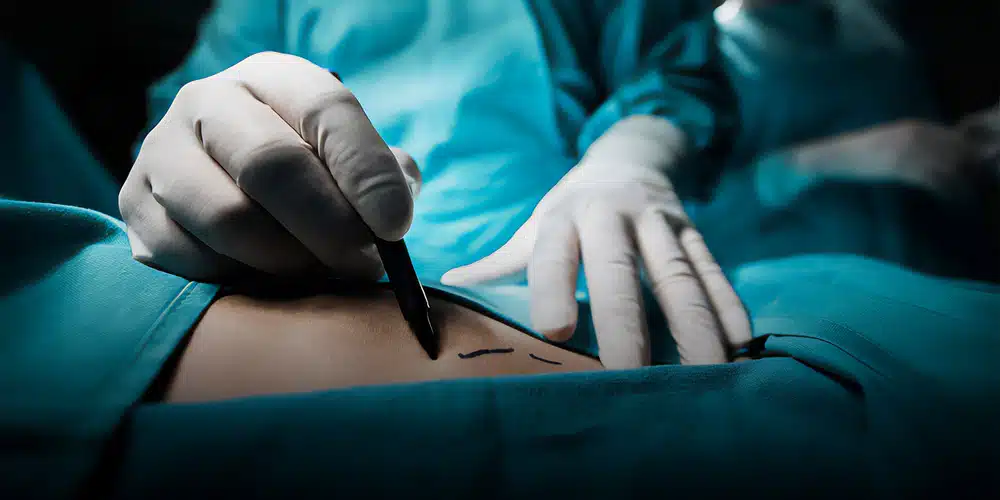
Open-Sleeve Gastrectomy
Open-sleeve gastrectomy is the base surgery technique performed through a large, open incision in the abdomen rather than using minimally invasive laparoscopic methods.
During open surgery, your surgeon makes an incision of 6 inches or more to access the stomach directly. The surgeon then staples and divides the stomach to create a tubular gastric sleeve, removing approximately 80% of the stomach. The open approach is rarely used today given improvements in laparoscopic surgery. However, open-sleeve gastrectomy may be necessary in certain cases where technical factors prevent a laparoscopic procedure.
For example, people who have significant abdominal adhesions or scarring from past surgeries may not be suitable candidates for laparoscopic access. The drawbacks of open surgery include longer recovery times, increased pain, higher risk of infection, and visible scarring from the large incision site.
Which Types of Gastric Sleeve Surgery is Right for You?
Obesity surgery in Turkey is typically only performed on adult patients who meet the necessary criteria.
However, in rare cases, teens may be considered suitable candidates if they have extreme, life-threatening obesity along with serious weight-related diseases.
In any case, there are several factors to consider when determining which type of gastric sleeve surgery is the best choice:
- Laparoscopic sleeve gastrectomy (LSG) is the most common and proven technique. It’s minimally invasive, with a shorter hospital stay, faster recovery, and low complication rate compared to open surgery. LSG would be a good option for most patients.
- Robotic-assisted sleeve gastrectomy provides enhanced 3D visualization and precision movements from the robotic instruments. This could benefit complex cases but is not yet widely available in most clinics around the world.
- Single incision sleeve gastrectomy (SILS) leaves only one hard-to-see belly button scar. The aesthetic result appeals to some patients. However, SILS may not be suitable for higher BMIs and is performed by limited surgeons currently.
- Revisional sleeve gastrectomy is an option if the original surgery was unsuccessful. An experienced bariatric surgeon can determine if a revision to a different procedure like gastric bypass is preferable.
- Open-sleeve gastrectomy is rare today given the advantages of minimally invasive laparoscopy.

Preparing for Gastric Sleeve Surgery
Proper preparation helps set the stage for smooth healing and optimal results after your procedure.
First, you must refrain from eating or drinking anything for 12 hours before the scheduled operation. The goal is to make your stomach completely empty to prevent complications from food or liquid contents remaining inside during surgery. The preparation also includes:
New Eating Habits
If you meet the eligibility criteria and are approved for gastric sleeve surgery, the next step is a 2-week pre-operative liquid diet. Your surgeon will provide specific diet guidelines to follow. The purpose of this restricted diet is to shrink fat deposits in the abdomen and liver prior to surgery, which improves safety and access during the procedure.
No Smoking
You need to stop smoking at least 1 month before surgery. Smoking impairs healing by reducing circulation and immune function. Quitting significantly decreases risks and supports proper recovery.
The Right Supplies
You may need to stock up on some groceries and supplies that align with your new nutrition plan. Having compliant foods on hand for the immediate recovery period is extremely helpful.
The Right Clothes
You also may need to expand your wardrobe with adjustable items you can wear as your body shape evolves during weight loss progression.
The Continuous Support
Connect with bariatric support communities. Speaking with others who have undergone the surgery provides better understanding and encouragement as you navigate changes.

The Gastric Sleeve Surgery Procedure
The procedure of gastric sleeve unfolds through different steps that start with anesthesia administration. The steps include:
- Your surgeon will make a small, half-inch incision in your abdomen and insert a port through the incision.
- Next, they will pump carbon dioxide gas through the port to expand your abdominal cavity to give the surgeon more room to operate.
- They will insert a small, lighted video camera called a laparoscope through the port. This camera will project live video of your internal organs onto a screen to guide the surgeon.
- Additionally, they will make one to three more small incisions and insert more ports through them.
- Through these additional ports, the surgeon will insert long, narrow surgical tools to complete the gastric sleeve procedure.
- Using these tools, the surgeon will first measure out and mark where the gastric sleeve will be created.
- Then, they will use a surgical stapler to divide and separate the remainder of the stomach from the sleeve portion.
- Afterward, the surgeon will remove the excess portion of the stomach, leaving only the new, smaller gastric sleeve.
- Finally, the incisions will be closed using special stitches.
Recovery and Post-Operative Care
After your surgery, you will stay in the hospital for 2 to 5 days. Laparoscopic surgery usually requires a shorter hospital stay than open surgery.
During your hospital stay, nurses will monitor your health and symptoms. On the second day after surgery, you will start with clear liquids for breakfast and advance to protein shakes for lunch if you can tolerate them.
You will use breathing devices and compression boots to prevent lung and circulation issues. The urinary catheter will be removed 1 day after surgery as you become mobile again.
Around the first couple of days, you will start moving and walking with assistance. This prevents complications and speeds recovery. Once discharged, you will receive instructions to follow:
- Over 6 weeks, slowly progress your diet from full liquids to soft foods to solids. Take nutritional supplements since you will be eating less. Drink plenty of fluids to avoid dehydration.
- Walk daily. This helps you recover and improve your fitness. Avoid strenuous activity and heavy lifting for 3-6 weeks to allow incisions to fully heal.
- Don’t drive until 1 week after surgery and off prescription pain medications. The medications can impair driving ability.

Dietary Effects and Lifestyle Changes
After surgery, you will receive a diet plan that slowly reintroduces food. This gradual process allows your digestive system to heal.
Initially, you will only have water and fluids like thin soups for the first few days. Soft, puréed foods are introduced around the first 4 weeks.
Between weeks 4-6, you can have mashed foods like potatoes. After 6 weeks, you can steadily return to a healthy, balanced diet.
It’s also recommended to eat slowly, chew thoroughly, and only have small portion sizes, especially early in recovery.
Avoid or limit foods like white bread that could clog your smaller stomach pouch. Take prescribed vitamins and mineral supplements since you will be eating less food overall.
This postoperative diet allows your body to adapt to the changes from surgery while providing needed nutrition. The stages from clear liquids to soft foods give your stomach time to recover its function.
In time, you can enjoy a variety of healthy foods again. Close adherence to your diet instructions promotes the best surgical results.

Cost and Insurance Considerations
The cost for gastric bypass surgery starts at around 3000 US dollars in Turkey and 12000 US dollars in countries such as the United States. For laparoscopic gastric bypass, which is less invasive, expect to pay up to 18,500 US dollars.
This pricing covers pre-operative testing and evaluation, surgeon, and anesthesiologist fees, a 2-night hospital stay, and post-operative nutritionist visits.
Unfortunately, despite proven benefits for conditions like diabetes and sleep apnea, many insurance plans still don’t cover weight loss surgeries. When they do provide coverage, costs may be lower for the patient, but insurance companies often have extensive prerequisites like 6 months of physician-supervised diet programs first.
By paying cash up front, you can undergo the procedure on your desired timeline, without waiting to meet insurance requirements.
Read more about: Obesity surgery cost in Turkey
While expensive, weight loss surgery has been life-changing for many people by resolving obesity-related illnesses and improving quality of life. In any case, the estimated cost of the procedure in different locations can be given as follows:
| Turkey | 2800-3500 US dollars |
| United Kingdom | 10000-15000 US dollars |
| United States | 12000-20000 US dollars |
| Canada | 10000-17000 US dollars |
| Australia | 9000-15000 US dollars |
| Mexico | 3000-4000 US dollars |
Patient Stories and Testimonials
Patients’ stories and testimonials provide great insight into what it’s like to have the surgery. At International Clinics, we receive thousands of international patients who undergo different types of gastric sleeve each year. Below are some of their testimonials (we’re using their initials only for privacy reasons).
“I just had the laparoscopic sleeve gastrectomy after a long time of reading and researching. The doctor at the clinic went in through some small cuts and took out most of my stomach. Recovery wasn’t cool but I’m already seeing results. I’ve lost 20 pounds in the last 2 months. For anyone thinking about getting the sleeve, I say go for it in Turkey.”
- Patient T.N. (42 years old female from Norway)
“I got the sleeve last year at this clinic and it’s been straight fire. I’ve lost mad weight and can finally fit into my old clothes again. The surgery was kinda robotic as they told me and it wasn’t too bad – just a little sore for a few days after.”
- Patient J.R. (31 years old female from U.S.A)
“The surgery itself was painless since they went in laparoscopically through a few small incisions in my abdomen. Recovery was a little rough the first week – I ain’t gonna lie, I was really sore and tired. But after that first week I started feeling better everyday. This surgery WORKED.”
- Patient J.M (45 years old male from Irland)
Frequently Asked Questions (FAQs)
The most common type is laparoscopic and open-sleeve gastrectomy. There is also open-sleeve gastrectomy and revisional gastric sleeve surgery.
The main difference between laparoscopic and open-sleeve gastrectomy is the size of the incisions. Laparoscopic uses several small incisions with the assistance of a camera, while open uses one large incision.
The eligibility criteria tend to be the same regardless of surgical technique. Candidates should have a BMI over 40, or over 35 with obesity-related health conditions.
Laparoscopic sleeve gastrectomy is minimally invasive, so benefits include smaller incisions, less pain, lower infection risk, shorter hospital stay, and faster recovery compared to open surgery.
Open-sleeve surgery has higher risks than the laparoscopic approach. Large incisions can increase the chances of infection and hernia. Recovery periods are longer with more pain.
The surgical team will recommend the best incision approach based on each patient’s unique situation. Those who are candidates for laparoscopic sleeve surgery often prefer it over the open technique.
A typical recovery is 1-2 weeks for laparoscopic procedures, 3-4 weeks for open surgery, and similar for revisional procedures.
Current Statistics and Research
We can provide a quick overview of the current statistics and research related to gastric sleeve types as follows:
Gastric Sleeve Success Rate
Studies show that the gastric sleeve has a high success rate of around 80-90% for significant weight loss. This is particularly true for the laparoscopic procedure.
However, according to research by the American Society for Metabolic and Bariatric Surgery, some weight regain is common. In fact, 50% of patients may gain back a small amount of weight (about 5% on average) two or more years after surgery.
Despite this, the majority are still able to maintain most of the weight loss long-term following the procedure.

Gastric Sleeve Complications Rate
According to one study, gastric sleeve surgery resulted in much lower complication and reoperation rates compared to Lap Band procedures. This suggests the gastric sleeve is less prone to issues requiring additional surgery. However, some patients do experience ongoing side effects.
read more about: Gastric sleeve side effects
For example, up to 20% of patients who undergo gastric sleeve surgery see an increase in heartburn and acid reflux after the procedure. When this occurs, it can be managed with medications like proton pump inhibitors and antacids. Additionally, up to 15% of patients may develop gallstones in the first year following surgery due to rapid weight loss.

Conclusion
Gastric sleeve weight-loss surgery is a procedure that decreases the size of the stomach to encourage weight loss. It is the most popular form of weight-loss surgery today.
During this surgery, approximately 80% of the stomach is surgically removed, leaving only the tube-like portion of the stomach intact. However, there are different types of surgery including open, laparoscopic, revisional, and robotic gastric sleeve.
Regardless of the type, the surgery leads to much less room for food in your stomach, which will make you feel full faster and unable to eat as much as you used to eat, so your body won’t produce as much ghrelin, the ‘hunger hormone.’
We made this guide to help patients be more informed about the popular types of procedures so they can make conscious decisions.
International Clinics provides different types of gastric sleeve and gastric bypass procedures. You can contact us directly to learn more about our packages and offers for international patients.
